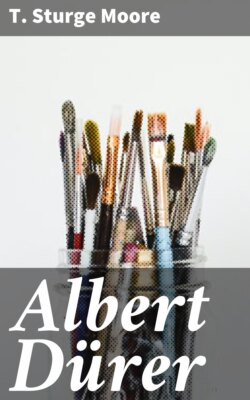Читать книгу Albert Dürer - T. Sturge Moore - Страница 38
На сайте Литреса книга снята с продажи.
VII
ОглавлениеTable of Contents
When I returned home, Hans Prey treated with my father and gave me his daughter, Mistress Agnes by name, and with her he gave me two hundred florins, and we were wedded; it was on Monday before Margaret's (July 7) in the year 1494.
The general acceptance of the gouty and irascible Pirkheimer's defamation of Frau Dürer as a miser and a shrew called forth a display of ingenuity on the part of Professor Thausing to prove the contrary. And I must confess that if he has not quite done that, he seems to me to have very thoroughly discredited Pirkheimer's ungallant abuse. Sir Martin Conway bids us notice that Dürer speaks of his "dear father" and his "dear mother" and even of his "dear father-in-law," but that he never couples that adjective with his wife's name. It is very dangerous to draw conclusions from such a fact, which may be merely an accident: or may, if it represents a habit of Dürer's, bear precisely the opposite significance. For some men are proud to drop such outward marks of affection, in cases where they know that every day proves to every witness that they are not needed. He also considers that her portraits show her, when young, to have been "empty-headed," when older, a "frigid shrew." For my own part, if the portrait at Bremen (see opposite) represents "mein Angnes," as its resemblance to the sketch at Vienna (see illus.) convinces me it does, I cannot accept either of these conclusions arrived at by the redoubtable science of physiognomy. The Bremen portrait shows us a refined, almost an eccentric type of beauty; one can easily believe it to have been possessed by a person of difficult character, but one certainly who must have had compensating good qualities. The "mein Angnes" on the sketch may well be set against the absent "dears" in the other mentions her husband made of her, especially when we consider that he couples this adjective with the Emperor's name, "my dear Prince Max." Of her relations to him nothing is known except what Pirkheimer wrote in his rage, when he was writing things which are demonstrably false. We know, however, that she was capable, pious, and thrifty; and on several occasions, in the Netherlands, shared in the honours done to her husband. It is natural to suppose that as they were childless, there may have existed a moral equivalent to this infertility; but also, with a man such as we know Dürer to have been, and a woman in every case not bad, have we not reason to expect that this moral barrenness which may have afflicted their union was in some large measure conquered by mutual effort and discipline, and bore from time to time those rarer flowers whose beauty and sweetness repay the conscious culture of the soul? It seems difficult to imagine that a man who succeeded in charming so many different acquaintances, and in remaining life-long friends with the testy and inconsiderate Pirkheimer, should have altogether failed to create a relation kindly and even beautiful with his Agnes, whose portrait we surely have at her best in the drawing at Bremen. Considerations as to the general position of married women in those days need not prevent us of our natural desire to think as well as possible of Dürer and his circumstances. We know that for a great many men the wife was not simply counted among their goods and chattels, or regarded as a kind of superior servant. We are able to take a peep at many a fireside of those days, where the relations that obtained, however different in certain outward characters, might well shame the greater number of the respectable even in the present year of grace. We know what Luther was in these respects; and have rather more than less reason to expect from the refined and gracious Dürer the creation of a worthy and kindly home. Why should we expect him to have been less successful than his parents in these respects?
[Illustration: AGNES FREY. DÜRER'S WIFE (?)--Silver-point drawing heightened with white on a dun paper. Kunsthalle, Bremen]
[Illustration: "MEIN ANGNES"--Pen sketch of the artist's wife, in the Albertina at Vienna]
